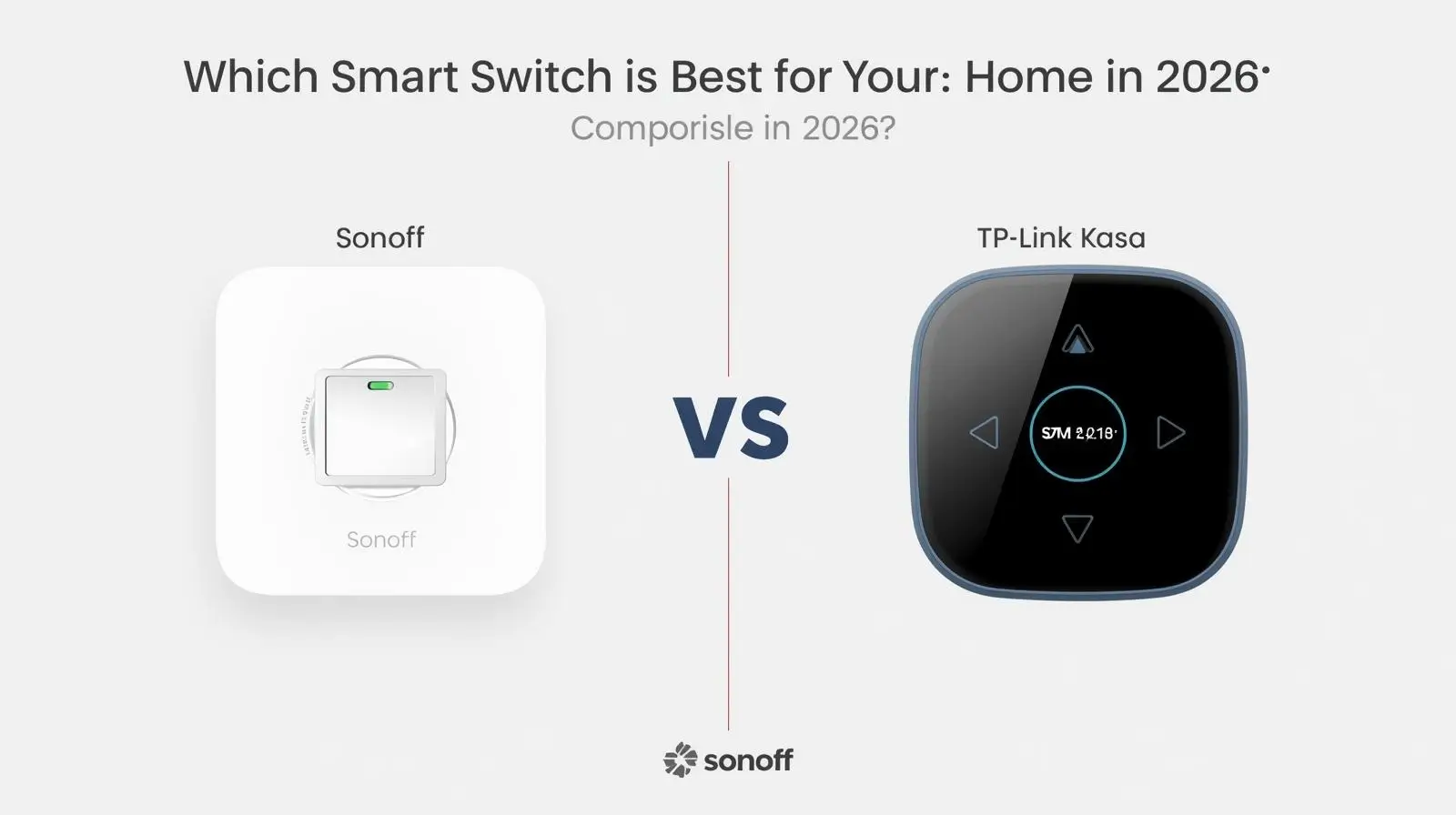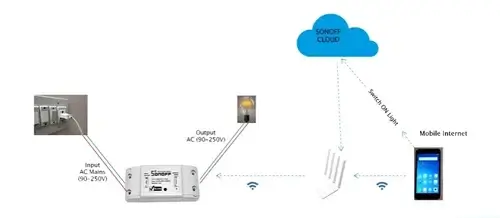Smart homes are getting more popular every day. People are adding smart controls to lights, fans, and gadgets to make life easier. Two top brands for smart switches are Sonoff and TP-Link Kasa. Both are good, but they shine in different ways.
In this simple guide, we'll compare them step by step. We'll look at key things like ease of setup and reliability. This will help you pick the right one for your home in 2026.
🧠 Key Things to Check in a Smart Switch
Before buying, think about what matters most to you. Here's a quick list:
| Feature | Why It Matters |
|---|---|
| Reliability | It should turn on/off quickly without glitches. No one wants flickering lights! |
| Wiring & Setup | Some need a "neutral" wire in your wall. Check your home's wiring first. |
| Local vs Cloud Control | Local means it works without internet. Cloud needs Wi-Fi but adds remote access. |
| App & Connections | Works with Alexa, Google, or Apple Home? Easy app setup? |
| Security | Regular updates to stop hackers. Safe passwords are key. |
| Price & Build | Cheap is nice, but it should last and feel solid. |
| Extra Features | Like dimming lights or tracking energy use. |
Your needs vary – maybe you want simple setup over fancy extras. Let's see how Sonoff and Kasa stack up.
📦 Example Products (2025-2026 Style)
We'll use these common ones for our chat:
- Sonoff: MINIR4M (tiny module with Matter support for easy connections).
- Sonoff: MINIR2 (for two switches in one spot).
- TP-Link Kasa: HS200 (basic one-switch light control).
- TP-Link Kasa/Tapo: S220 (newer model for multiple switches).
Both brands have lots of options, so pick based on your setup.
🏗️ Setup & Wiring: How Easy Is It?
Sonoff
Most Sonoff switches need a neutral wire (a common wire in modern walls). The MINIR4M is a tiny box that fits behind your old switch – great for old homes without replacing everything. Some have "Magic Switch Mode" – turn off the wall switch, but control from your phone anyway. Perfect for low-power lights.
Pros: Super small, easy to hide in tight spots.
Cons: Still needs neutral in many cases.
Kasa
Kasa switches like the HS200 also need a neutral wire. The app walks you through setup with pictures – super beginner-friendly. But older homes without neutral? You might need an electrician.
Pros: Feels like a normal wall switch, simple app guide.
Cons: Not as flexible for hidden installs.
Winner? Tie for most homes. Sonoff wins for DIY retrofits; Kasa for straightforward wall swaps.
🔄 Control: Local (No Internet) or Cloud?
Sonoff
Older ones rely on cloud (eWeLink app) for remote stuff. But new Matter models like MINIR4M work locally – no cloud needed, and it plays nice with other brands. Some let you tweak firmware for full local control if you're handy.
Pros: Getting better at offline use with Matter.
Cons: Cloud is still key for some features.
Kasa
Mostly cloud-based, but newer firmware lets basics (on/off, timers) work locally. Matter support is coming to more devices by 2026, so offline control improves. The app handles everything smoothly.
Pros: Solid local basics already.
Cons: Full smarts might need internet.
Winner? Kasa slightly ahead for reliable offline now. Both get better with Matter in 2026 – expect no-internet worries to fade.
🧩 Connections & App: Works with Your Stuff?
Sonoff
Uses eWeLink app for scenes and sharing. Matter models connect to Apple Home, Google, Alexa, and more – one app rules them all. Some act as hubs for other gadgets.
Pros: Flexible for tech fans; Matter opens doors.
Cons: Older ones might need updates to join new systems.
Kasa
Great app for automations and schedules. Works seamlessly with Alexa and Google; Matter adds Apple and others. Users love the rock-solid links.
Pros: Easy with big names like Alexa.
Cons: Some extras (like energy tracking) lag in Matter.
Winner? Kasa for simple voice setups. Sonoff for custom hubs and tinkerers. Matter makes both mix well in 2026.
🛡️ Reliability, Safety & Updates
Sonoff
Newer ones (like R-series) are stable and zippy. Tech users flash custom firmware for tweaks. Updates fix security holes, but check for old device support.
Pros: Custom options boost reliability.
Cons: Early models had glitches (fixed now).
Kasa
Known for "set it and forget it" – rarely fails. Firmware is steady, but past security issues (like weak encryption) were patched. Both brands need strong Wi-Fi security.
Pros: Long-term dependability.
Cons: Rare cloud hiccups.
Winner? Kasa for hassle-free use. Sonoff if you like hands-on fixes. Always update firmware!
🔧 Features: What Can They Do?
Here's a quick side-by-side:
| Feature | Sonoff | Kasa |
|---|---|---|
| Price | Cheaper modules (~$10-15) | A bit more for wall types (~$15-25) |
| Hidden Installs | Tiny size wins for tight boxes | Good for walls, less sneaky |
| Wall Switch Tricks | Magic Mode keeps remote on even if switch is off (for some lights) | Basic – off means off, unless bypassed |
| Dimming | Some models do it well for LEDs | Strong dimmers like HS220 |
| Energy Tracking | Good in new Matter models | Improving, but app-only sometimes |
| Scenes & Hubs | eWeLink + gateways for big setups | App scenes shine; Matter for mixing |
| Offline | Strong with Matter/DIY | Basics local; more coming |
| Updates | Good for new lines | Mature and reliable |
Best For? Sonoff for budget tweaks; Kasa for polished dimming and energy info.
🧪 What Real People Say
- Kasa: "I've used Kasa switches for years – reliable, no headaches." Another: "Nearly flawless, just reset every 6 months."
- Sonoff: "Compact MINIR4M is perfect behind switches – Matter makes it easy." "Rock solid once set up."
Both get thumbs up, but Kasa feels "safer" for newbies.
🏁 Who Wins in 2026?
Pick Sonoff if:
- You like cheap, tiny modules for DIY.
- You're okay flashing firmware or using Matter for local fun.
- Need a hub-like setup for extras.
Pick Kasa if:
- Want easy install and zero fuss.
- Love Alexa/Google and a slick app.
- Prefer stable, everyday reliability.
Pro Tip: Mix 'em! Kasa for living rooms (steady), Sonoff for garages (flexible). Matter in 2026 lets them talk, so your smart home grows easy.
Smart switches make life brighter – choose what fits your vibe! 🚀




